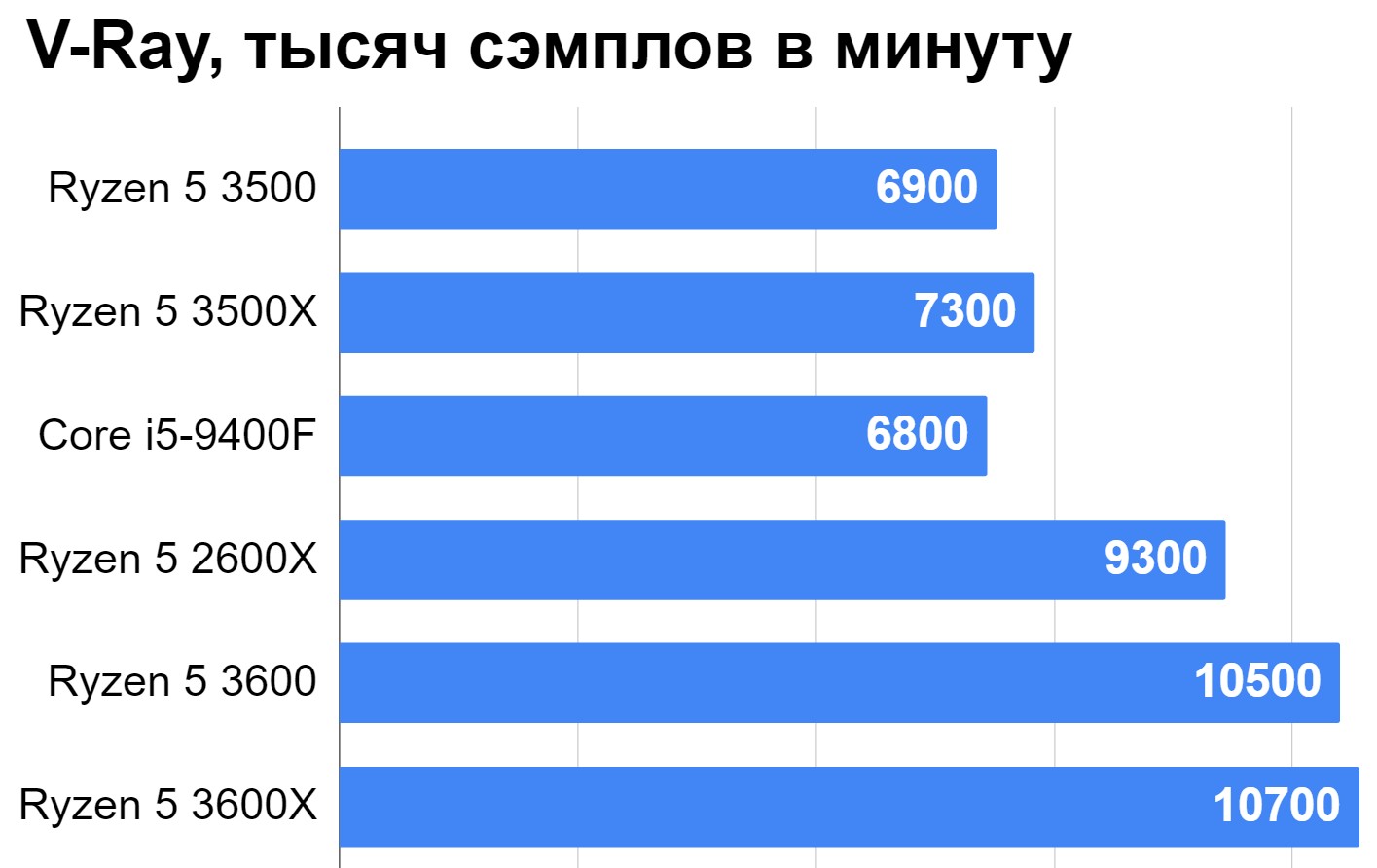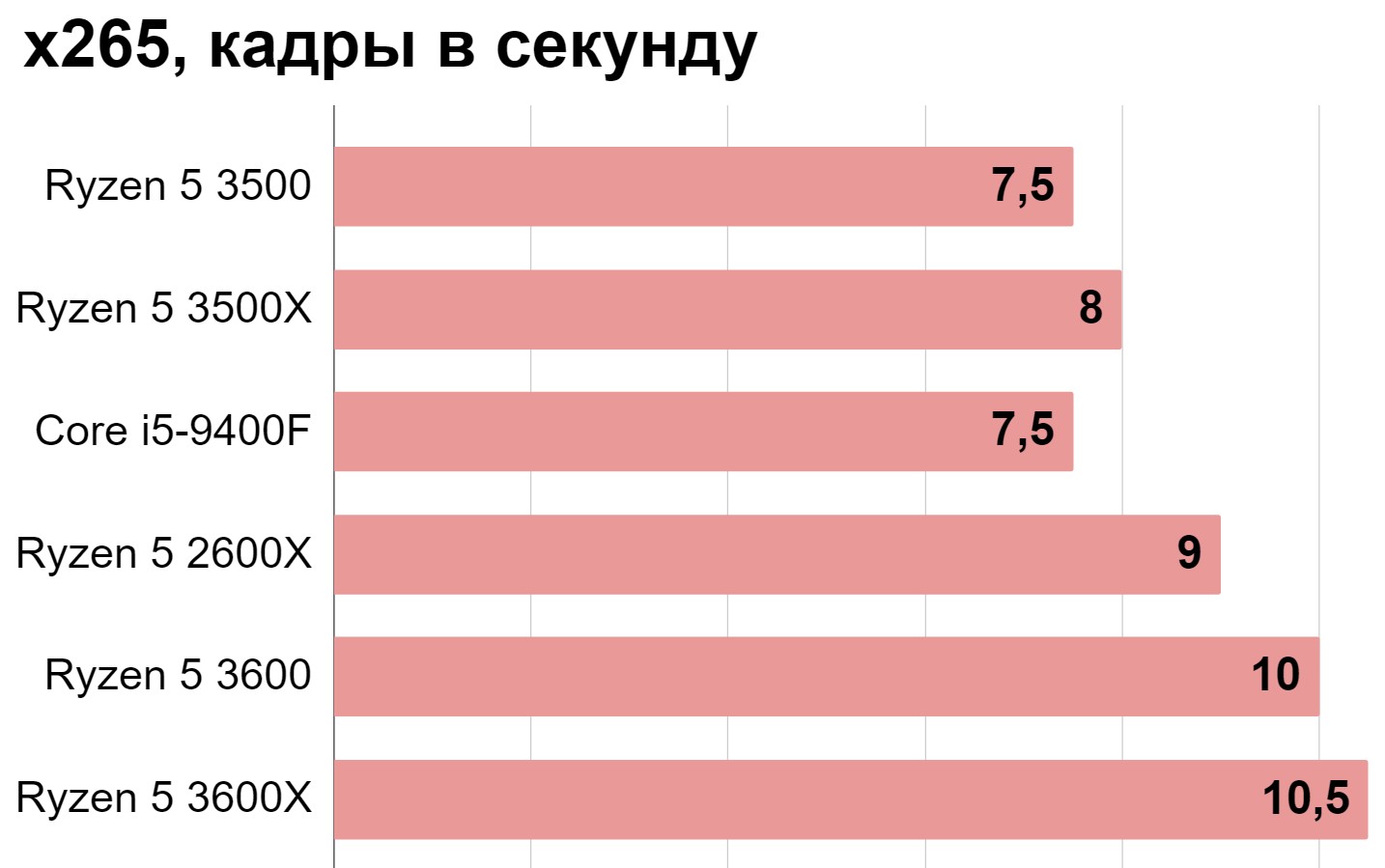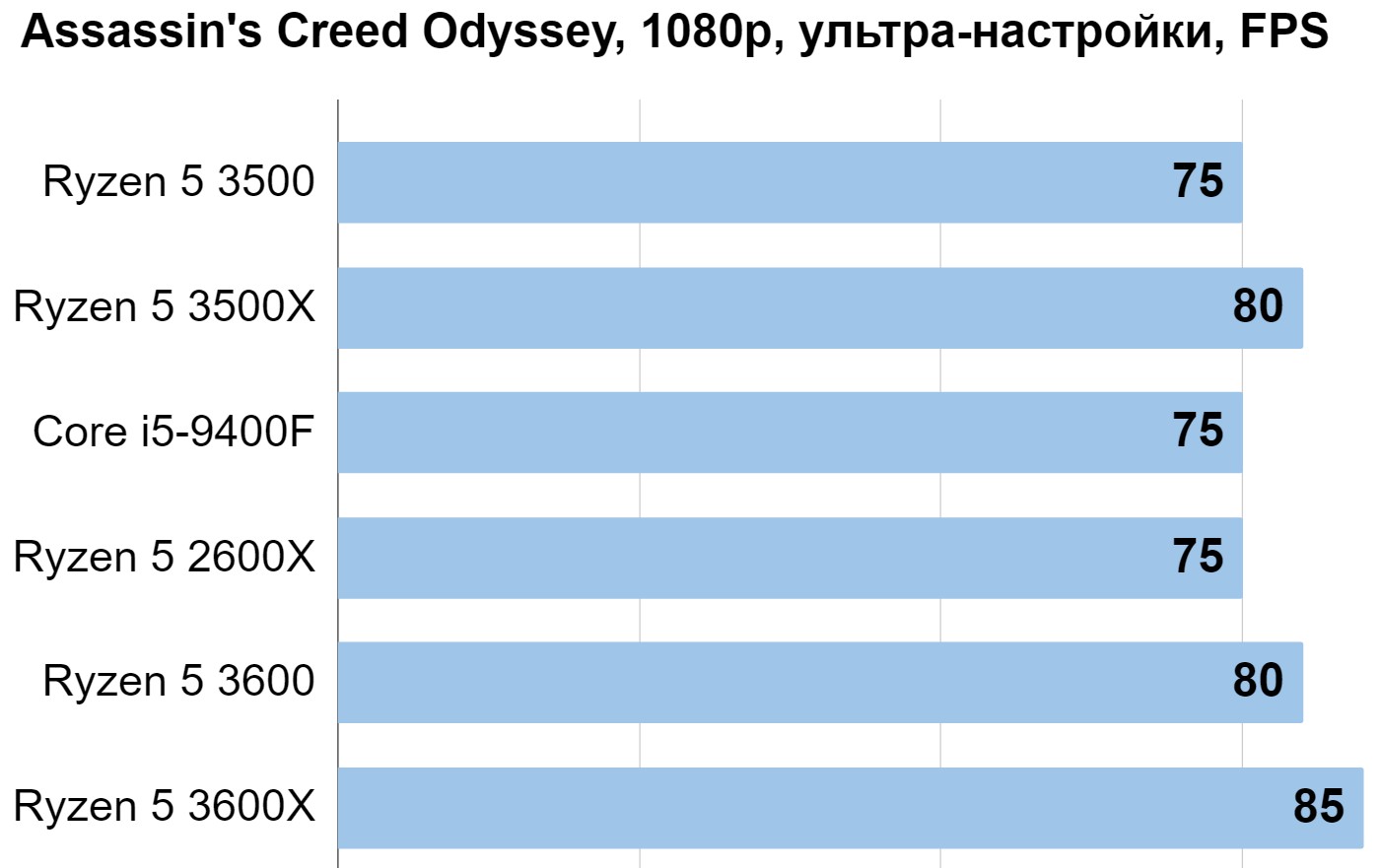AMD Ryzen 5 3500 "popular" processor review and comparison with 2600X, 3500X, 3600 and 3600X
We independently test the products and technologies that we recommend.

Market positioning
The direct competitor of the Ryzen 5 3500 from the Intel camp is the Core i5-9400F: the same six cores without multithreading, smaller and slower cache, higher price, but faster memory controller and boxed cooler included. But it's much more interesting to compare the 3500 to other Ryzen 5 chips.
- The 2600X is a twelve-thread processor of the old Zen + architecture (lower performance per clock), relatively hot (TDP 95 W), but the remnants are being sold at a very “tasty” price, and even with a cooler with a copper core.
- 3500X is an exclusive version of the Ryzen 5 3500 with double the cache (32 vs. 16 MB), while the rest of the characteristics, including the base and boost frequencies, are identical, they are not officially sold in our area, but can be ordered from abroad, a purely tri-version without cooler.
- The 3600 is the youngest twelve-threaded Zen 2 processor, relatively low-frequency, but also relatively cold, already with a simple Wrath Stealth cooler in the kit.
- The 3600X is an older twelve-thread processor with a 200 MHz higher frequency, which translates into a significant increase in power consumption and heating (95 vs. 65 W), but is compensated by the improved bundled Wrath Spire cooler.
 |

| Rozetka.ua | 4 910 ₴ | To Store |
AMD Ryzen 5 3500 is a new low-cost gaming and work processor that has caught up and even outperformed the competing Core i5-9400F. It has six physical cores of the latest Zen 2 architecture without SMT multithreading and 16 MB L3 cache (only 9 MB for the i5-9400F). And the Ryzen 5 3500X, which is currently only sold in China, has an even more capacious cache — as much as 32 MB.
The frequency formula of the Ryzen 5 3500, like the 3500X, is 3.6 – 4.1 GHz (base frequency and Precision Boost on one core, respectively). With a parallel load on all cores, the processor usually operates at a frequency of 3.9 GHz. And by manual overclocking, if you're lucky with a successful copy of the chip, you can boost the frequency up to 4.2 GHz.
Traditionally for Ryzen processors, regardless of generation, memory bandwidth plays an important role. Therefore, it will not be superfluous to get a kit of RAM with a higher frequency, since Matisse chips on X570 motherboards conquer the frequency with a 1: 1 synchronous bus up to 3600 MHz. In most games, the six-core Ryzen 5 3500 performs roughly on par with the more expensive twelve-thread Ryzen 5 3600. The only exceptions are Assassin's Creed Odyssey and Watch Dogs 2, which can load at least 32 threads.
Also, parity is observed in streaming, recording let's plays and video editing, because in this case the main part of the load falls on a discrete graphics card. Perhaps the only daunting task for the non-threaded Ryzen 5 3500 is professional 3D modeling in 3Ds Maximum But even a 12-thread 3600 is rather weak for it, you need at least a 16-thread 3700X/3800X, or better a flagship 3950X with 16 cores and 32 threads. Fortunately, you can spend the first time on the low-cost Ryzen 5 3500, and then upgrade to a more powerful processor without replacing the motherboard.

AMD Ryzen 5 3600X is an older twelve-thread processor based on the 7nm Zen 2 architecture. It has a more “aggressive” frequency formula than the younger brother Ryzen 5 3600: 3.8 – 4.4 GHz versus 3.6 – 4.2. This is achieved by manually selecting the most successful CCD chiplets from the batch, as well as by increasing the supply voltage to about 1.3 V and, as a result, power consumption and heating up to 95 W (against 65 W for the 3600).
Fortunately, the Ryzen 5 3600X has a better boxed cooler: not a miniature all-aluminium Wrath Stealth, but a mid-sized Wrath Spire. This allows Precision Boost 2 technology to automatically overclock the processor across all cores to a frequency of 4.0 – 4.1 GHz. Taking into account the increased IPC (instructions per clock) and doubled cache (32 vs. 16 MB), the advantage over the previous Ryzen 5 2600X on the 12nm Zen + architecture is 25 percent.
In the case of using a large tower cooler or a two-section dropsy, as well as a motherboard with support for Load-Line Calibration technology, the Ryzen 5 3600X can be manually forced to work stably at a frequency of 4.3 – 4.4 GHz across all cores. Whereas processors with numerous cores, such as the sixteen-thread Ryzen 7 3700, usually, are not able to achieve such high home overclocking results. The same goes for the younger Ryzen 5 3500, which often uses less successful chiplets.
It turns out that the 3600X is actually AMD's highest clocked processor at the moment and is best suited for gaming for that reason. The only weak point of AMD processors is the RAM controller, which in the case of Matisse is also placed in a separate IOD chiplet. Because of this, the latency (latency) of DDR4-3600 MHz memory is as much as 70 ns, while the competing Intel Core has only 50 ms. However, Ryzen Matisse more than compensate for this with twice the faster L3 cache.
Test bench configuration
- cooler Noctua NH-U12S chromax.black Price from 3 397 up to 4 800 ₴;
- motherboard MSI MPG X570 GAMING EDGE WIFI ;
- RAM Team Group Dark Z Alpha DDR4 TDZAD416G3600HC18JDC01 ;
- graphics card INNO3D GeForce RTX 2080 Ti GAMING OC X3 ;
- SSD block='price' idgood='1545883' !!!};
- HDD Seagate BarraCuda Compute ST4000DM004 4 TB 256/5400 Price from 3 798 up to 5 570 ₴;
- power unit ;
- frame Chieftec SCORPION 2 black ;
- monitor AOC CQ32G1 32 " black .
Test results
The V-Ray 3D modeling benchmark clearly demonstrates the advantage of the new Zen 2 architecture over the old Zen+, as well as the large and fast Ryzen cache over the small and slow Core i5. Processors with virtual multithreading in V-Ray are expected to be ahead. The x265 video editing benchmark gets a noticeable increase in performance also from the increased processor frequency. But the WebXPRT web browser benchmark reacts weakly to multithreading, but strongly to cache and frequency.
 |
 |
 |
To make sure nothing hinders the performance of processors in games, frame rate measurements were taken with the flagship GeForce RTX 2080 Ti graphics card. So, in Metro Exodus, which requires more power per core than the number of core-threads, all tested processors are kept at about the same level (90 – 105 FPS). In turn, in Assassin's Creed Odyssey, the FPS spread is already larger — from 115 to 140, and Zen 2 chips with multithreading show a significant advantage. Finally, in Assassin's Creed Odyssey, the superiority of the new Zen 2 architecture and large cache is most felt.
 |
 |
 |
findings
Our tests have confirmed it clearly: at the moment, the Ryzen 5 3500 is undoubtedly the best low-cost processor for gaming and work. If in auto overclocking mode it slightly lags behind the average FPS value in some games from the competing Core i5-9400F, then after manual overclocking, the lag is completely leveled. And in work applications, due to the more capacious and faster cache, the Ryzen 5 3500 leaves no chance for the 9400F.
Most impressive is the work done over the year to optimize the architecture. Even in many work applications, not to mention games, the new Zen 2 is noticeably faster than the old Zen +. Buying a twelve-core 2600X instead of a six-core 3500 in 2020 is clearly not worth it. However, there is no need to rush to change the already existing 2600X to 3600 or 3600X either. The old man still has a margin of productivity for a couple of years.
Choosing exclusively from the 3000-series Ryzen 5, we would prefer either the ultra-low-cost 3500 or the older 3600X right away. However in both the first and second cases, you will have to pay extra for at least a simple tower cooler. Since no cooling is supplied with the 3500 processor at all, and the bundled 3600X cooler can hardly cope with the removal of 95 W of heat (the temperature of 85°C is not critical, but still a bit high). Considering all of the above, we are waiting with sincere interest for the first details about the upcoming Zen 3 architecture based on the improved 7+ nm process technology.
Articles, reviews, useful tips
All materials
















